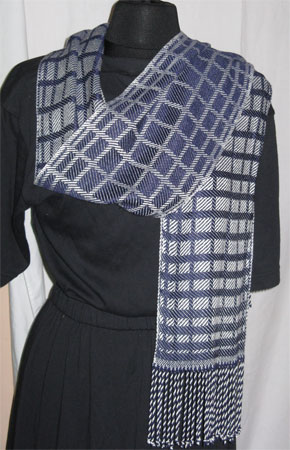Late last month I showed the twill block scarves I wove with silk on a gray warp. They were successful, but didn’t have as much contrast as I was looking for.
So I tried the concept again, this time with a white bamboo warp and three different colors of bamboo weft.
The first one I did was with a black weft.

THIS was the kind of contrast I was looking for! You can easily see the difference between the front and the back of the scarf.
I didn’t have any black bamboo that was the same size as the white, only a much finer yarn, so I used two strands at once. Experience has taught me that unless those two strands are spun together, they will never come off a bobbin the same way — one will always be longer than the other, causing much difficulty about half way through a bobbin. I don’t spin, so I wound two separate bobbins and used my double shuttle.
As usual (for me), I didn’t want to make all three scarves on the warp the same color, but I wanted to keep the colors quite distinct, so I used navy the second time. While close in concept to the black, I had the size yarn I needed, so only needed a single shuttle.
It was just as successful as the black.

I do like the scarves, but the concept I was going for with the sizes of the blocks isn’t as obvious as I’d like, given the length of the scarves. I had the blocks much thinner at all 4 edges and gradually increase near the middle of the scarf. If I’d been making a placemat, or even a table runner, the optical illusion of the piece bulging in the center would have been much more obvious.
For the last scarf I used a bright red, and liked it equally well.

I modified my treadling pattern on this one, simply alternating my smallest block and my largest block all along the length of the scarf. It was easier to remember, and had a look that was just fine.
This bamboo yarn separates quite easily upon wet finishing and wearing, so the fringe had to be twisted. For the red scarf, I simply twisted up the white warp yarn. Experience has taught me, however, that if I just twisted the white yarn for a scarf as dark as the navy and black, that the eye would get jarred, and the fringe would seem wrong. So I carefully added the black and navy yarn to my fringe before twisting. This added more work, and for the navy scarf twice as much twisting, but I’m happy with the result.
Why was the navy scarf more twisting than the black one? Well, as I mentioned the black yarn was much thinner. So I could add two doubled lengths of black yarn, resulting in four strands, and they didn’t add much bulk. I decided to simply twist two strands of black into the four strands of white, so ended up with the same number of fringe ends. The navy yarn was much thicker, so when I added two doubled strands of it, I would have had fringe that was too thick to look good. As a result, each twisted pair is made from four strands of navy and four strands of white for a more candy cane effect. This means twice as much fringe. I was a bit concerned that it would be too much, but I think it’s just fine.
I’ll be interested to see the reaction to these scarves at my upcoming shows. That’ll tell me whether I should make more of them.
Your turn: After a VERY dry July, August has finally brought us rain, and I’m enjoying it. How about you?


Leave a Reply